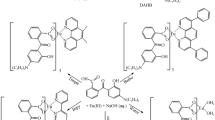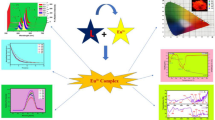Abstract
In present work, five novel europium complexes [Eu(L)3·Phen (2), Eu(L)3·Bipy (3), Eu(L)3·Neo (4), Eu(L)3·Biq (5) and Eu(L)3·Batho (6)] were synthesized, derived from [Eu(L)3·2H2O] (1) complex by using ligand (HL) 5-hydroxy-2-(hydroxymethyl)-4H-pyran-4-one and coligands 1,10-phenanthroline, bipyridine, neocuproine, 2,2′-biquinoline and bathophenanthroline. In order to seek excellent photoluminescent properties, coligands were introduced in the complexes to form a rigid conjugated system, thus enhancing luminescence properties of complexes. The synthesized complexes reveal four narrow characteristic emission lines of Eu(III) consistent with 5D0 → 7FJ transitions, where J = 0, 1, 2 and 3 at about 580, 595, 614 and 650 nm, respectively. The 5D0 → 7F2 transition is responsible for strong red luminescence. Color coordinate diagram also indicates that x, y coordinates lie in deep red region. Thermal data are in favour of high thermal stability of synthesized compounds. Owing to their high thermal stability and strong red luminescence, these complexes might be used in fabrication of optoelectronic devices.
Graphic abstract










Similar content being viewed by others
References
Ashooriha M, Khoshneviszadeh M, Khoshneviszadeh M, Moradi SE, Rafiei A, Kardan M, Emami S. 1,2,3-Triazole-based kojic acid analogs as potent tyrosinase inhibitors: design, synthesis and biological evaluation. Bioorgan Chem. 2019;82:414.
Siddiquee S. Recent advancements on the role of biologically active secondary metabolites from Aspergillus. In: Gupta VK, editor. New and future developments in microbial biotechnology and bioengineering. Amsterdam: Elsevier; 2018, 69.
Vasconcelos HA, Feitosa ECA, Barreto AS, Santos DO, Filho JCS, Silva GH, Mesquita ME, Sussuchi EM. Synthesis, characterization and properties of lanthanide ions with kojic acid. In: Proceedings of the annual meeting of the Brazilian Chemical Society-Chemistry making a better future, Sao Paulo. 2010, 1.
Dutta DP, Tyagi AK. Inorganic phosphor materials for solid state white light generation. Solid State Phenom. 2009;155:113.
Kido J, Okamoto Y. Organo lanthanide metal complexes for electroluminescent materials. Chem Rev. 2002;102(6):2357.
Takada N, Tsutsui T, Saito S. Strongly directed emission from controlled-spontaneous-emission electroluminescent diodes with europium complex as an emitter. J Appl Phys. 1994;33(6B):863.
Hemmila I. Luminescent lanthanide chelates—a way to more sensitive diagnostic methods. J Alloys Compd. 1995;225(1–2):480.
Kido J, Nagai K, Okamoto Y. Organic electroluminescent devices using lanthanide complexes. J Alloys Compd. 1993;192(1–2):30.
Cristiano R, Westpal E, Bechtold IH, Bortoluzzi AJ, Gallardo H. Synthesis and optical/thermal properties of low molecular mass V-shaped materials based on 2,3-dicyanopyrazine. Tetrahedron. 2007;63(13):2851.
Klink SI, Grave L, Reinhoudt DN, Veggel FCJM, Wertz MHV, Geurtz FAJ, Hofstraat JWA. Systematic study of the photophysical process in polydentate triphenylene-functionalized Eu3+, Tb3+, Nd3+, Yb3+, and Er3+ complexes. J Phys Chem A. 2000;104(23):5457.
Bao J, Zhang Z, Tang R, Han H, Yang Z. Synthesis and fluorescence properties of Tb(III) complex with a novel aromatic carboxylic acid (L) as well as spectroscopic studies on the interaction between Tb(III) complex and bovine serum albumin. J Lumin. 2013;136:68.
Devi R, Chahar S, Khatkar SP, Taxak VB, Boora P. Judd-Ofelt characterization and energy transfer mechanism of highly luminescent europium(III) complexes with 1-(5-chloro-2-hydroxyphenyl)1,3-butanedione. Inorgan Chim Acta. 2018;471:364.
Taha ZA, Ajlouni AM, Hijazi AK, Al-Rawashdeh NA, Al-Hassan KA, Al-Haj YA, Ebqaai MA, Altalafha AY. Synthesis and luminescent spectroscopy of lanthanide complexes with dimethylpyridine-2,6-dicarboxylate (dmpc). J Lumin. 2015;161(1):229.
Wang YB, Zheng XJ, Zhuang WJ, Jin LP. Hydothermal synthesis and characterization of novel lanthanide 2,2′-diphenyldicarboxylate complexes. Eur J Inorgan Chem. 2003;2003(7):1355.
Biju S, Raj DBA, Reddy MLP, Kariuki BM. Synthesis, crystal structure and luminescent properties of novel Eu3+ heterocyclic β-diketone complexes with bidentate nitrogen donors. Inorgan Chem. 2006;45(26):10651.
Devi R, Bala M, Khatkar SP, Taxak VB, Boora P. Investigation of luminescent behaviour and intramolecular energy transfer mechanism of europium(III) complexes with fluorinated β-ketoester ligand. J Fluor Chem. 2016;181:36.
Xu J, Zhang Y, Chen H, Liu WS, Tang Y. Efficient visible and near-infrared photoluminescent attapulgite-based lanthanide one-dimensional nanomaterials assembled by ion-pairing interactions. Dalton Trans. 2014;43(21):7903.
Wang H, He P, Yan H, Gong M. Synthesis, characteristics and luminescent properties of a new europium(III) organic complex applied in near UV LED. Sens Actuators B Chem. 2011;156(1):6.
Balamurugan A, Reddy MLP, Jayakanna M. Single polymer photosensitizer for Tb3+ and Eu3+ ions: An approach for white light emission based on carboxylic-functionalized poly (m-phenylenevinylene)s. J Phys Chem. 2009;113(43):14128.
Ferreira K, Pires P, Castro BD, Sa Ferreira RA, Carlos LD, Pischel U. Zirconium organophosphonates as photoactive and hydrophobic host materials for sensitized luminescence of Eu(III), Tb(III), Sm(III) and Dy(III). New J Chem. 2004;28(12):1506.
Wertz MHV, Jukes RTF, Verhoeven JW. The emission spectrum and the radiative lifetime of Eu3+ in luminescent lanthanide complexes. Phys Chem Chem Phys. 2002;4(9):1542.
Hazenkamp MF, Blasse G. Rare-earth ions adsorbed onto porous glass: luminescence as a characterizing tool. Chem Mater. 1990;2(2):105.
Stanimirov S, Petkov I. Photophysical properties of novel fluorescent poly(oxyethylene phosphate) tris(β-diketonate) europium (III) complexes. Spectrochim Acta A Mol Biomol Spectrosc. 2009;72(5):1127.
Khatkar SP, Kumar R, Khatkar A, Taxak VB. Synthesis, characterization, enhanced photoluminescence and biological activity of Eu(III) complexes with organic ligands. J Mater Sci Mater Electron. 2015;26(9):7086.
Wang H, He P, Yan H, Gong M. Synthesis, characteristics and luminescent properties of a new europium (III) organic complex applied in near UV LED. Sens Actuators B Chem. 2011;156(1):6.
Latva M, Takalo H, Mukkala VM, Matachescu C, Ubis JCR, Kankare J. Correlation between the lowest triplet state energy level of the ligand and lanthanide(III) luminescence quantum yield. J Lumin. 1997;75(2):149.
Yang C, Luo J, Ma J, Lu M, Liang L, Tong B. Synthesis and photoluminescent properties of four novel trinuclear europium complexes based on two tris-β-diketones ligands. Dyes Pigm. 2011;92(1):696.
Liu JY, Ren N, Zhang JJ, Zhang CY. Preparation, thermodynamic property and antimicrobial activity of some rare-earth (III) complexes with 3-bromo-5-iodobenzoic acid and 1,10-phenanthroline. Thermochim Acta. 2013;570:51.
Lakshmanan R, Shivaprakash NC, Sindhu SN. Spectral characterizations and photophysical properties of one-step synthesized blue fluorescent 40-aryl substituted 2,2′:6′,2″-terpyridine for OLEDs application. J Lumin. 2015;168:145.
Kumar V, Gohain M, Van Tonder JH, Ponra S, Bezuindenhoudt BCB, Ntwaeaborwa OM, Swart HC. Synthesis of quinoline based heterocyclic compounds for blue lighting application. Opt Mater. 2015;50:275.
Bala M, Kumar S, Boora P, Taxak VB, Khatkar A, Khatkar SP. Enhanced optoelectronics properties of europium(III) complexes with β-diketone and nitrogen heterocyclic heterocyclic ligands. J Mater Sci Mater Electron. 2014;25(7):2850.
Acknowledgements
This work was financially supported by the project from University Grant Commission, New Delhi (No. F. 30–39/2014 (BSR).
Author information
Authors and Affiliations
Corresponding author
Electronic supplementary material
Below is the link to the electronic supplementary material.
Rights and permissions
About this article
Cite this article
Dhania, S.L., Chauhan, A. & Langyan, R. Synthesis, characterization and photoluminescent properties of Eu(III) complexes with 5-hydroxy-2-hydroxymethyl-4H-4-pyranone and N,N′-donor heterocyclic coligands. Rare Met. 40, 1118–1125 (2021). https://doi.org/10.1007/s12598-020-01387-4
Received:
Revised:
Accepted:
Published:
Issue Date:
DOI: https://doi.org/10.1007/s12598-020-01387-4




